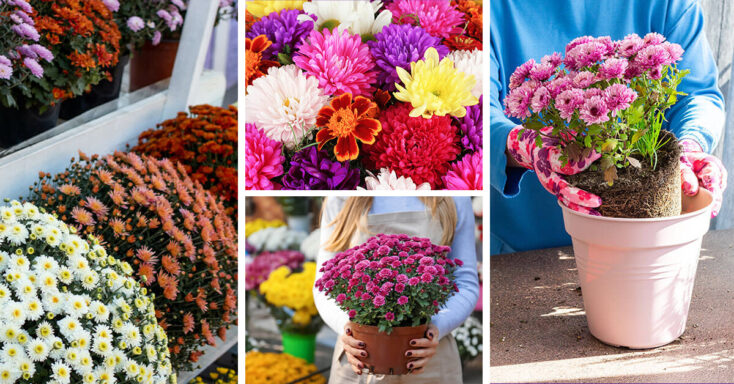When it comes to autumn, chrysanthemums are ranking queens. One bloom is actually a composite of tiny florets within. You can find these lovely flowers at hundreds of nurseries, all of which have different heights, colors, and blooming times. Unless you buy a cold-hardy plant, you can consider your mums as annuals. In either case, plant them in spring to maximize chrysanthemum care.
Key Takeaways
- Chrysanthemums prefer filtered light (6 hours daily).
- Mums adapt equally well to being planted in the yard or in pots.
- These flowers need elbow room – sow them 3 feet apart.
- For a bushier plant, pinch off new stalks when they are about 3 inches tall.
Mum’s the Word
There are 13 types of mums classified by the National Chrysanthemum Society, one of which is sure to suit your tastes.
- Anemone: The raised centers of this flower look like an old-fashioned pincushion. They bloom mid-fall, bringing color while other plants die off. Example: Shock
- Brush and Thistle: Some of the florets on this plant grow delicately upright. The rest are horizontal. Example: Wisp of Pink
- Decorative: Flatter than some varieties with short florets that bend downward. Often called garden mums, they bloom from September to October. Example: Grandchild.
- Irregular: These flowers have a loose curve toward the middle of the plant. They grow 4 feet tall with a spread of 10 inches. Example: Seiko
- Intermediate Incurve: A middle man between the Irregular and Regular incurves in both size and shape. They have looser florets. Example: San Tropez.
- Pompom: Just like the same sounds, these globes range in size from 1 to 4 inches. They are simply cute. Example: Moonbeam
- Quill: As the name implies, these look like feather quills. They will reach heights of about 3 feet, blooming in late summer. Example: Saffina
- Reflex: The petals curve down and overlap. In some ways, this pattern looks like bird feathers. Blossoms measure from 4-6 inches in diameter. Example: Domingo
- Regular Incurve: A traditional shape, incurving petals in the shape of a ball. The densely packed petals measure 4-6 inches in diameter. Example: Rosedew.
- Single and Semi-Double: Blooming in mid-season and appearing a bit like daisies, their flowers are 2-3 inches. Example: Donna
- Spider: The spider mum has large flowers and thread-like florets. These reach outward, often turning at the end. Think of fireworks going off, only in flower form. Example: Seaton’s Galaxy
- Spoon: A mid-season bloomer, this chrysanthemum is quite distinctive. Their ray florets end in little cups, fit for the fey. Example: Maryl.
- Unusual: Like any group, you need a category that groups in plants that don’t quite fit elsewhere. Example: Satin Ribbon
An Ancient Flower: The Chinese originally cultivated Chrysanthemums, writing about them some 3,000 years ago. In the healer’s kit, these flowers became remedies for things like headaches. There are four noble plants in Chinese culture. Chrysanthemum is one. The others are plum, orchid, and bamboo. Each flower represents the four seasons and virtues. Chrysanthemum’s season is fall, and the virtue is nobility.
Chrysanthemum Care
Some say chrysanthemums are difficult to care for. That’s really not the case. With the right soil, water, and sunshine, they’re content. The only thing mums need is plucking dead flower heads right away.
If you start a chrysanthemum in a pot, you can transfer it into the soil. Just cut it down to about 6 inches and plant it in a sunny spot with good drainage. You can add some organic compost to your soil to boost the plant’s energy. They feed heavily.
TIP: Make sure your potted plants aren’t in a spot where they receive light from your porch or the street. This will slow the budding process.
Your mums thrive best when planted in spring. Set them about 3 feet apart (less if they are smaller cultivars).
The generalized meaning of chrysanthemums is joy and a positive attitude. Looking more closely, in Japan, there is a National Chrysanthemum Day (September 9) nicknamed the “Festival of Happiness.” They hold this flower in such high regard that there is a military award, the Supreme Order of the Chrysanthemum, which is the highest honor the Emperor can bestow.
Outdoor Chrysanthemum Needs
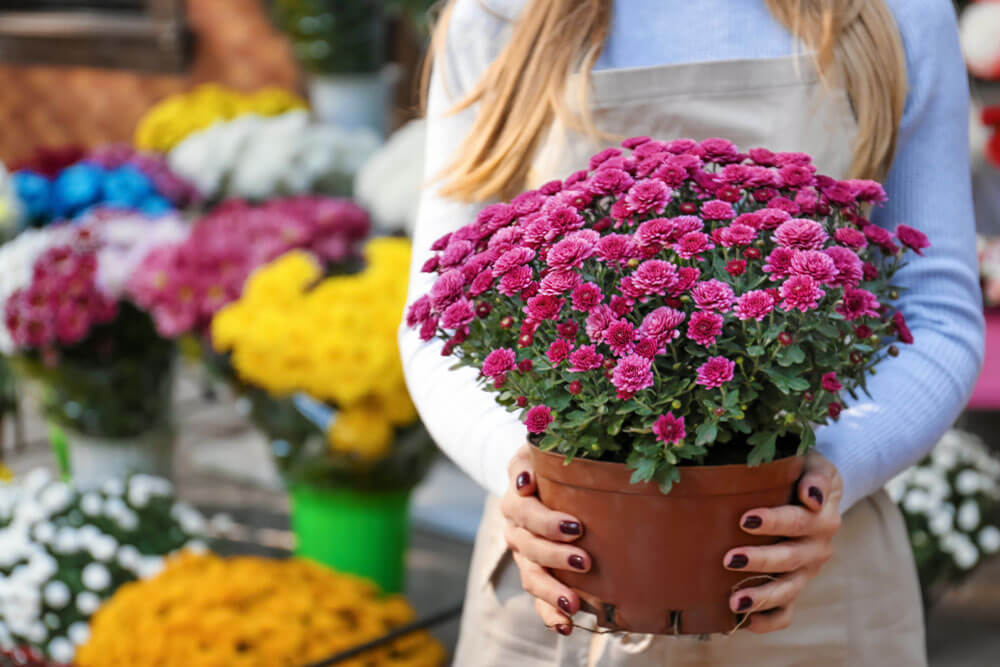
Mums are pretty straightforward plants. You need to keep their soil moist (not too dry and not too wet). Always water at the base of the plant.
Your mums are hungry and benefit from receiving a balanced fertilizer monthly (10-10-10). When you put the mums into the ground, mulch them. This deters weeds and conserves the soil moisture around the plant. You can stop fertilizing once there are buds.
If you’re looking for a bushy plant, the key is in pinching. When new shoots appear and reach 4” tall, pinch off the top. Make sure there are always 3 leaves on a shoot. Continue this process until you see buds developing.
Varieties Beyond Words: The Chrysanthemum name comes from two Green works: chrysos and anthemon, meaning gold flower. But these days, Chrysanthemums are anything but just gold. You can choose from orange, pink, purple, red, white, and yellow. Along with color, each has a specific size and floral pattern.
Buying Chrysanthemums for Your Garden
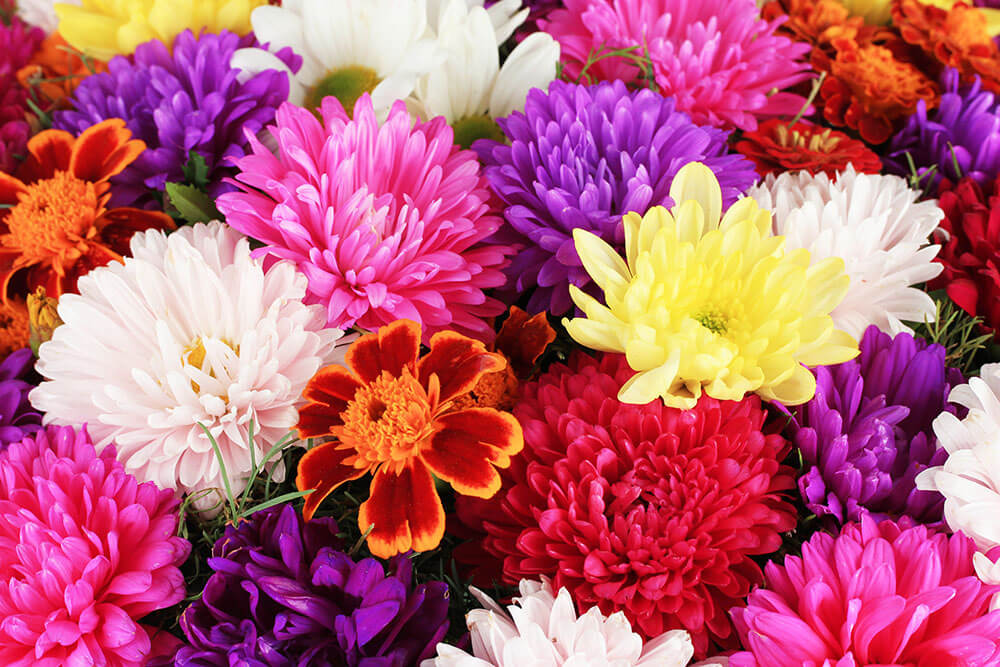
Estimates place the varieties of chrysanthemums near the 20,000 point so that you won’t be wanting for options. Of those, forty are naturally occurring.
- Allouise Pink: Grows to 4 feet tall. It’s very bushy and bears large flowers shaded in salmon pink. Because of its size, it’s ideal for the back of your garden, where it can show off over smaller plants.
- Anastasia Green: Grows to 3 feet tall bearing pale green “quills.” The flowering season is from autumn until the hard frost. You can use these as decorative cut flowers.
- Bolero: Grows a scant 2 feet tall with delicious-looking apricot flowers. Bolero offers dense blooms ideal as border plants.
- Brennpunkt: These appear somewhat like dahlia. The flower is blood red with double flowers. It’s a standout in the garden come fall.
- Bronze Elegance: These grow no more than 3 feet tall. The flowers are dark pink, moving into a yellow center. Stunning against dark green foliage.
- Clara Curtis: Looking like a pink daisy dotted in the center with yellow, this compact flower grows to 2 feet. These chrysanthemums do well in containers.
- Coup de Solei: Enjoy bronze flowers with yellow bases. The blossoms appear in September until November. This plant’s name means “touch of sun.”
- Debutant: If you want something to light up your garden in late fall, Debutant fills that role (she’s always late to the ball!). Can grow 3 feet tall and bear fuchsia blossoms.
- Dernier Soleil: A sweet flower with vibrant yellow centers slowly turning into peachy-orange petals. Under the best circumstances, this chrysanthemum blooms from August until the frost.
- Dexter Orange: Dexter Orange bears copper-colored petals. It is a vigorous double-bloom flower atop long stems. Cold tolerant.
- Homecoming: It’s hard to describe this stunning 3-foot-tall chrysanthemum. It looks like a cheerleader’s pom pom but not so dense. The flowers are dusty pink and creamy white.
- Granatapfel: A hybrid with clean red petals margined in yellow. The name means pomegranate. Grows to be about 2 feet tall.
- Little Bee (‘Bienchen): Pompom-shaped flower. Each has red centers surrounded by golden-yellow petals. Blossoms in September. Has a habit of branching.
- Moonbeam: Tightly formed crisp white flowers as round as a full moon. Can sometimes grow over 3 feet tall.
- Pat Lehman: One word: PEACHY! 1 ½ foot of glorious flower, these blossom late summer and early fall.
- Rumpelstilzchen: This chrysanthemum has glorious double-red flowers. The blossoms are on the small size, measuring under 2 inches. Blooms from September to October.
The Chinese enjoy chrysanthemum tea, made from dried flowers. They may also add the leaves to salads. It’s best to gather the flowers yourself or get them from an organic supplier. Make yourself a treat with .2 oz dried chrysanthemum flowers and three cups of water. Put the petals into a strainer. Boil the water and place the strainer into it. Steep for 5 minutes. A little honey is a nice touch.
Watering Techniques for Outdoor Chrysanthemum
When you first plant your chrysanthemum, you want it completely soaked to about 5 inches down. When you only give your plant regular light sprinklings, roots may not form properly. Always apply water directly to the soil, avoiding splatters on the foliage.
If you notice sad, droopy foliage or leaves turning brown, your plants are saying, Hey! I’m thirsty. If a chrysanthemum’s roots dry out, it’s nearly impossible to revive the plant. Conversely, waterlogged plants often lead to root rot (and they smell pretty bad).
Watch for the signals your garden provides. With time and attention, you’ll naturally know the rhythm of your plants and can care for them better.
What’s Bugging You? Chrysanthemums can protect against frustrating insects, like mosquitos. Unfortunately, just stuffing your garden full with them isn’t quite enough. Rather, the condensed oil extracted from chrysanthemum is the hero of the day. On bug repellants, it appears as “pyrethrum.”
Potting and Repotting Outdoor Chrysanthemums
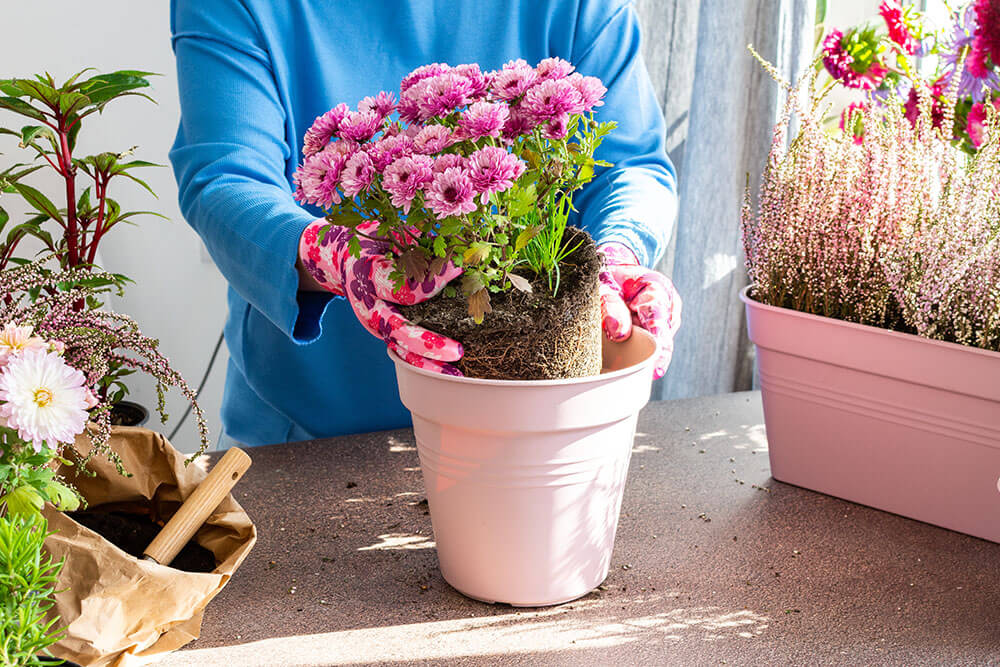
Mums do well with division every 2 to 3 years. Remove the plant from the pot or soil, and remove the old growth. Cut the rest into sections, each of which has roots and several shoots. Plant them.
When you first buy these flowers, they often come home rootbound. So give them a space 1-2” larger (diameter) than previously. Make sure to use soil with good organic ingredients. If your yard wants for nutrients, you may need to amend the soil before planting. Also, wherever you put your chrysanthemum, remember it needs excellent drainage (runoff). If you can hold off on moving your plants until autumn when they’re actively blooming, that’s best.
Floral Arrangements: When you’re thinking cut flowers, chrysanthemums are long-lasting. They remain fresh for between 2 and 4 weeks. If you change the water regularly, that extends their life even longer.
Chrysanthemum Pruning and Maintenance
Come the spring, it’s time to cut back your mums, stopping about July 4th. Going too long into July can hinder fall flowers. When left to their own, they may grow leggy and unable to hold up blossoms. Pinch back your plant to maintain a compact shape. Without pruning, your summer blossoming period may be short.
When your plant reaches 6 inches tall in spring, begin pinching. Go to about 3 inches above the soil, above the leaf. New stems start growing. As those new stems reach 6 inches, pinch them back again.
The Victorian Language of Flowers not only assigned symbolism to plants but also to each color of a plant. So, each color of a chrysanthemum has a slightly different connotation. Red traditionally means passion, white loyalty, purple thoughtfulness, and violet a wish for health and renewal.
Blooming and Resting Periods
Once they begin blooming, mums last for between 4 and 8 weeks. Each variety has a different time at which they’re expected to bloom, going from late July until October’s end. There are only some mums that are cold-hardy. If yours are not, it’s best to plant them in potters so you can overwinter them where it’s safe from frost.
If you live in USDA Zones 5 to 9, plant your mums in late September, covered with 3” of mulch. In colder zones, you should move the plant to a cool, dark place such as your basement or cellar. The best temperature range is 32F-50F. Sprits the roots periodically through winter so they don’t dry out completely. Wait until after the last killing frost to return them to your garden.
Chrysanthemum Factoids: If you were born in November, chrysanthemum is your birth flower. Chrysanthemums are not just one blossom, but rather a cluster of smaller flowers. Because chrysanthemums are the largest commercially produced flower in the United States, it has earned the designation Queen of Fall Flowers.
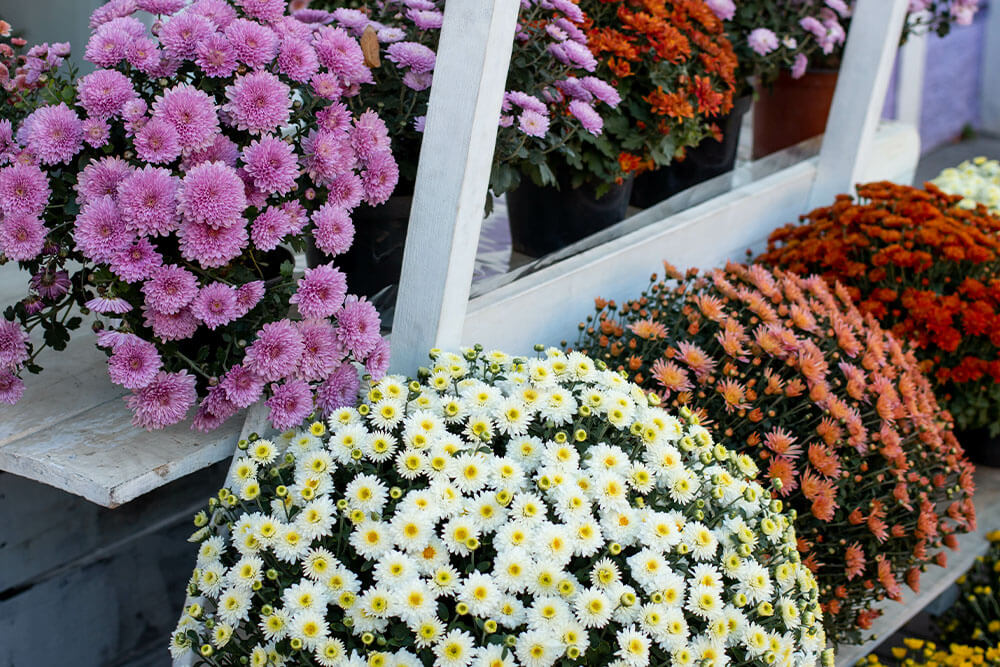
Chrysanthemum: Common Pests & Plant Diseases
Among the insects that may nibble on your flowers, aphids are typical. They suck on the plant’s sap, particularly new growth or the undersides of buds. The foliage, as a result, may slow in growth and look distorted. When aphids are around, sooty mold often follows because of the sticky substance the insect secretes. You can knock aphids off your plants with a solid spray of water. Do this every other day until you see no further signs.
Mites are also common, typically appearing when it’s hot and dry. These tiny critters have piercing mouths for puncturing the plant and sucking out the sap. The leaves on your plant develop yellow spots and look rather dusty. Flowers become discolored. Forceful water can work as it does on aphids, but if that doesn’t work, try insecticidal soap.
One disease that occurs is Leaf Spot. You’ll notice pinpoint spots of yellow that slowly become brown, and eventually black increasing to 1 inch. Lower leaves show problems the soonest, withering prematurely. Look to fungicides for assistance.
An ancient Chinese legend tells of an elderly emperor who heard rumors of an herb that would grant eternal youth. The stories said it grew on Dragonfly Island, and could only be picked by young people. Curious and hopeful. The emperor sent twenty-four children to the island. Oddly, upon arrival, nothing was there but a golden chrysanthemum. It now represents family ties.
Troubleshooting Common Problems
Discolored leaves; mushy stems: too much water. Dry out the plant and make sure to provide proper drainage.
Flopping stems: Too much shade. Give your plant 6 hours of sun daily.
Woody stems; lower leaf loss: Underwatering. Adjust your watering schedule.
Blossoms and stem tips disappear: Potentially deer.
Folk Uses: People felt that having chrysanthemums around offered protection. The aroma inspires passion and romance. Magical practitioners saw it as a plant that motivates creativity and improves one’s connection to the world of Spirit.
Summary
With so many plants starting to fade come fall, chrysanthemums stand by to liven things up. They are not difficult flowers. Give them plenty of sun and moderate water. So doing increases the chance your mums will bloom until the first frost!
Frequently Asked Questions About Outdoor Chrysanthemums
How long do potted chrysanthemums last?
Mums have a lifespan of about five years.
How do you care for chrysanthemums indoors?
Pretty much the same as outdoor care. The plants need well-drained potting soil, and a window where they can receive indirect sunlight for 6 hours a day. At night if your home hovers around 65F, it’s ideal for healthy chrysanthemums.
What to do with chrysanthemums when they finish flowering?
Deadhead the plant. You can do this throughout the season, not just at the end. This can actually extend the bloom period.
How do you keep chrysanthemums alive?
Outdoors your mums need at least 18 inches of space all for themselves. They need an area for root expansion. Make sure you have proper drainage and organic compost. Keep an eye on water levels, making sure the plants remain moist.
Will potted mums survive winter?
It depends on where you live. Some chrysanthemums are cold hardy, but even they cannot withstand very harsh winters. This means wintering the plant in a safe location, like a shed where the temperature won’t go below 32F. During this time, the play will remain dormant.
Final Thoughts
The study of chrysanthemum diversity is worthy of a lifetime, and one filled with beauty. I find them delightfully easy, requiring little in the way of time investment (great when you’re on a busy schedule). Just pay attention to your plants. They’ll often tell you what they need just by the way they look.

